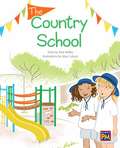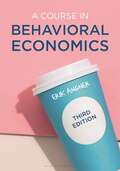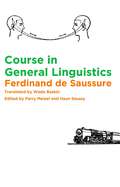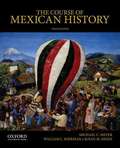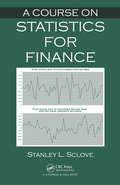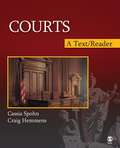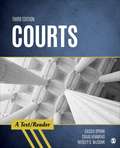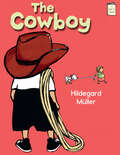- Table View
- List View
Countries and Their Currency [Beyond Level, Grade 3]
by McGraw-Hill EducationNIMAC-sourced textbook
Country Mouse and City Mouse
by Megan Howard David BergsteinThe fun and excitement of English and Language Arts learning continues in Grade 2 of Reading Street. This comprehensive and dynamic curriculum for homeschooling is geared toward young children who have some foundational English and Language Arts knowledge and are ready to strengthen their skills. Comprised of engaging activities, challenging content and weekly quizzes, Reading Street: Grade 2 is the next step in your child's path toward becoming a lifelong learner and reader. As with all Reading Street products, the Grade 2 system is formatted to help students meet certain age-appropriate goals. After completing this English and Language Arts homeschool program, your child should be able to: Read and comprehend two-syllable words. Identify common prefixes (such as pre-, un-, or re-) and suffixes (such as -able, -ad and -er). Correct mistakes made when reading out loud. Read books with two or more chapters. Understand the structure of stores (i. e. beginning, middle and end). Start selecting reading materials based on his/her own interests. Identify the "who," "what," "when," "where," "why" and "how" of the text. While the goals of second Grade English and Language Arts are numerous, Reading Street will help you craft engrossing lessons. Your child will garner important English and Language Arts skills while completing a workbook, reading stories and poems, and taking assessments. Planning these lessons will be easier than ever, as all Reading Street systems are broken down into weekly Big Ideas. All the work your child does on a given week is formulated around that single concept for an organized and challenging curriculum. With six easy-to-follow units, Reading Street: Grade 2 is the perfect tool for homeschooling parents. Your child will enjoy the reading selections and activities, and you'll love to see your student growing into a knowledgeable individual. We're confident that this product is the right one for you. For more information on the specific materials found in Grade 2 of Reading Street, check out the Features and Benefits page.
Country Mouse, City Mouse (Fountas & Pinnell Classroom, Guided Reading)
by Olga Ivanov Aleksey Ivanov Jennifer GillisNIMAC-sourced textbook
Courage Rock (Fountas & Pinnell Classroom, Guided Reading Grade 5)
by Jill Nadler Mike YoungCOURAGE! When Connor's hike with his daredevil cousin suddenly becomes dangerous, he's got to decide—what does it mean to be brave? NIMAC-sourced textbook
The Courageous Sailor
by Alison Adams Marcin Piwowarski Lori O'DeaA boy and his boat. Will today be the day Jose finally sets out in his boat? Or will he be too scared to go?
Course 1: Childhood and Growing Up - TNTEU (Course Material for B.Ed. (First Year))
by Tamil Nadu Teachers Education UniversityCourse Material for Course 1: Childhood and Growing Up for B.Ed.(First Year) (2016-2017) by the Department of Educational Psychology. The book is divided into 2 parts with 5 Units in each part.
Course 2: Contemporary India And Education - TNTEU (Course Material for B.Ed. (First Year))
by Tamil Nadu Teachers Education UniversityCourse Material for Course 2: Contemporary India And Education for B.Ed.(First Year) (2016-2017) by the Department of Educational Psychology. The book is divided into 2 parts with 5 Units in each part.
Course 3: Learning and Teaching - TNTEU (Course Material for B.Ed. (First Year))
by Tamil Nadu Teachers Education UniversityCourse Material for Course 1: Contemporary India And Education for B.Ed.(First Year) (2016-2017) by the Department of Educational Psychology. The book is divided into 2 parts with 5 Units in each part.
Course 7 (Course Material for B.Ed. (First Year))
by Tamil Nadu Teachers Education UniversityCourse Material for Course 7(A): Pedagogy of Physical Science for B.Ed.(First Year) (2016-2017) by the Department of Educational Psychology. The book is divided into 5 Units.
Course 7a: Pedagogy of English (Course Material for B.Ed. (First Year))
by Tamil Nadu Teachers Education UniversityCourse Material for Course 7a: Pedagogy of English for B.Ed.(First Year) (2016-2017) by the Department of Educational Psychology. The book is divided into 6 Units explaining the various importance and methods of learning English as a language.
Course 7a: Pedagogy of Geography (Course Material for B.Ed. (First Year))
by Tamil Nadu Teachers Education UniversityCourse Material for Course 7a: Pedagogy of Geography for B.Ed. (First Year) (2016-2017) by the Department of Educational Psychology. The book is divided into 5 Units.
Course 7a: Pedagogy of History (Course Material for B.Ed. (First Year))
by Tamil Nadu Teachers Education UniversityHistory is often said to be the “queen” or “mother” of the social sciences. It outdates the other social sciences, having appeared in schools long before the others with the possible exception of geography. It is the basis of all subjects of study which fall under the category of Humanities and Social sciences. It is also the basis of the study of philosophy, politics, economics and even art and religion. No wonder, it is considered an indispensable subject in the complete education of man. With this book take a journey for understanding the Pedagogy of History.
A Course in Behavioral Economics
by Erik AngnerThis textbook looks at decisions – how we make them, and what makes them good or bad. In this bestselling introduction, Erik Angner clearly lays out the theory of behavioral economics and explains the intuitions behind it. The book offers a rich tapestry of examples, exercises, and problems drawn from fields such as economics, management, marketing, political science, and public policy. It shows how to apply the principles of behavioral economics to improve your life and work – and to make the world a better place to boot. No advanced mathematics is required. <p><p>This is an ideal textbook for students coming to behavioral economics from various fields. It can be used on its own in introductory courses, or in combination with other texts at advanced undergraduate and postgraduate levels. It is equally suitable for general readers who have been captivated by popular-science books on behavioral economics and want to know more about this intriguing subject. <p><p>New to this Edition: <p><p>- An updated chapter on behavioral policy and the nudge agenda. <p><p>- Several new sections, for example on the economics of happiness. <p><p>- Updated examples and exercises, with an expanded answer key <p><p>- Refreshed ancillary resources make for a plug and play experience for instructors teaching behavioral economics for the first time.
Course in General Linguistics
by Ferdinand De Saussure Wade Baskin Perry Meisel Haun SaussyThis new edition of Ferdinand de Saussure'sCourse in General Linguistics (1916) is the first critical edition of Saussure to appear in English. It also restores Wade Baskin's delightful original English translation (1959), which has long been unavailable. The founder of modern linguistics, Saussure inaugurated semiology, structuralism, and deconstruction and made possible the work of Jacques Lacan, French feminism, cultural studies, New Historicism, and postcolonialism. Based on the lectures that Saussure gave at the end of his life at the University of Geneva, the text of theCoursewas collated from notes taken by Saussure's students and published by Charles Bally, Albert Sechehaye, and Albert Riedlinger. Saussure traces the rise and fall of the historical linguistics in which he was trained, the synchronic or structural linguistics with which he replaces it, and the new look of diachronic linguistics subsequent to this change in scholarly perspective. Most important, Saussure presents the general principles of a new linguistic science which includes among its achievements the invention of semiology: the theory of the "signifier," the "signified," and the "sign" which they combine to produce. Relaunching Baskin's translation restores these terms and makes Saussure's thought once again clear and accessible. Baskin's translation allows readers to experience how Saussure shifts the theory of reference from mimesis to performance and expands the purview of poetics to include all media, including life sciences and environmentalism. The introduction to this new edition situates Saussure's position in the history of ideas and describes the history of scholarship that made theCourse in General Linguisticslegendary. New endnotes enlarge Saussure's contexts well beyond linguistics to include literary criticism, cultural studies, and philosophy.
The Course of Mexican History (10th Edition)
by Michael C. Meyer William L. Sherman Susan M. DeedsMexico's political, social, and economic landscapes have shifted in very striking ways in recent years and the country now moves cautiously forward in the twenty-first century. Revised to address these remarkable transformations, The Course of Mexican History, now in its tenth edition, offersa completely up-to-date, lively, and engaging survey from the pre-Columbian times to the present. The leading textbook in its field, The Course of Mexican History, Tenth Edition, is indispensable for students of Mexican history, politics, economics, and culture.
A Course on Statistics for Finance
by Stanley L. Sclove<p>Taking a data-driven approach, A Course on Statistics for Finance presents statistical methods for financial investment analysis. The author introduces regression analysis, time series analysis, and multivariate analysis step by step using models and methods from finance. <p>The book begins with a review of basic statistics, including descriptive statistics, kinds of variables, and types of data sets. It then discusses regression analysis in general terms and in terms of financial investment models, such as the capital asset pricing model and the Fama/French model. It also describes mean-variance portfolio analysis and concludes with a focus on time series analysis. <p>Providing the connection between elementary statistics courses and quantitative finance courses, this text helps both existing and future quants improve their data analysis skills and better understand the modeling process.</p>
Court Reporting: Bad Grammar/Good Punctuation
by Margie Wakeman WellsThis book is a story of punctuation. Read in its entirety along with the exercises that parallel the chapters, this is an advanced course in punctuation for the court reporter, the court reporting student, or anyone who wants to truly understand punctuation.
Courts: A Text/Reader
by Cassia Spohn Craig HemmensIntended for graduate and undergraduate study of the judicial system, this textbook on the United States criminal court system provides an overview of the processes, research principles and classic case studies that define this institution. Spohn (criminology and criminal justice, Arizona State U.) and Hemmens (criminal justice, Boise State U.) have made the text for accessible for students who are not necessarily studying law, and they include discussion questions, readings and exercises that focus more on the practical aspects of courts and less upon legal theory. An online site provides additional Internet resources for students, and instructors can order an additional CD-ROM that contains a test bank, PowerPoint slides and classroom activities. Annotation ©2009 Book News, Inc., Portland, OR (booknews.com)
Courts: A Text Reader (Sage Text/Reader Series in Criminology and Criminal Justice)
by Cassia Spohn Craig T. Hemmens Wesley S. McCannThis book provides more in the way of text and pedagogy and uses recent research-based articles to help students understand courts. This book is unique in that it is a hybrid text/ reader offering the best of both worlds. It includes a collection of articles on courts that have previously appeared in a number of leading criminal justice/criminology journals along with original textual material that explains and synthesizes the readings. Some of the best recent research are selected and assembled in this text/reader for an undergraduate or graduate courts class.
Courts and Criminal Justice in America
by Larry J. Siegel Frank Schmalleger John L. WorrallCourts and Criminal Justice in America, Third Edition, is the collaboration of the most popular criminal justice authors of the century. Featuring a balanced and modern presentation, this book not only looks at the basic structure of the court system and court process, but also covers cutting-edge topics and all sides of the most controversial issues facing courts today. This student-friendly text does not presuppose any knowledge about the courts or how they operate. Highlighted controversial cases illustrate the tremendous power that the court system has to regulate citizens' lives, to shape what is acceptable and what is forbidden, and to ensure that criminal justice policy balances both rights and liberties. Extensively revised throughout, the Third Edition features new and updated statistics, chapter-opening stories, and Courts in the News and What Will You Do? features that challenge readers to think critically and draw their own conclusions. This respected author team delivers the most comprehensive introduction to America's courts, their personnel, and the context in which they operate on the market today.
The Cowboy (I Like to Read)
by Hildegard MullerAnna thinks the boy in the cowboy hat looks silly—but he's the only one who can save the day in this Guided Reading Level F story. It's a beautiful day! Anna and her toy dog, Toto, are all set to visit the beach, where the girl will teach her pup to swim. Toto is a quick learner, and Anna is having fun—until a wave pushes the floating toy far out into the ocean. No one knows how to save Toto—except for the boy in the cowboy hat, who leaps into action to lasso the wayward dog! Maybe he's not so silly after all. This richly-illustrated story about friendship and first impressions is perfect for young readers just beginning to tackle more complex sentence structures. The bright, charming artwork adds humorous detail—from Toto's tiny wheels to the Cowboy's aura of mystery—and helps support understanding of the text. The award-winning I Like to Read® series focuses on guided reading levels A through G, based upon Fountas and Pinnell standards. Acclaimed author-illustrators--including winners of Caldecott, Theodor Seuss Geisel, and Coretta Scott King honors—create original, high quality illustrations that support comprehension of simple text and are fun for kids to read with parents, teachers, or on their own! Level F books, for early first graders, feature longer, more varied sentences than Level E. Level F books encourage kids to decode new multi-syllable words in addition to recognizing sight words. Stories are more complex, and illustrations provide support and additional detail. When Level F is mastered, follow up with Level G.

